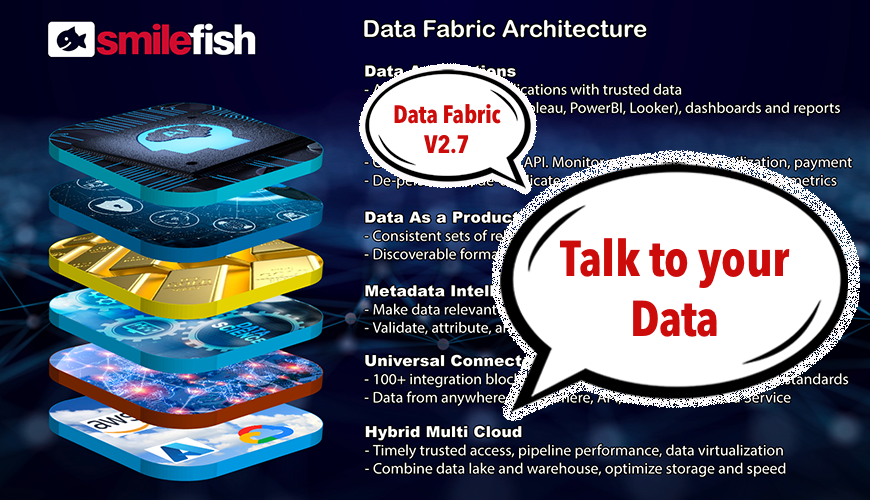Smilefish releases the Data Fabric V2.7
Newport Beach, CA - October 15th 2023

Smilefish Data Fabric
AI unlocks tremendous optimization potential for almost any business, but the outcome of any AI initiative is only as good as its training data. Positioning your company for maximized AI benefits requires a strategy for gathering and fostering reliable, dependable, and actionable data. The Smilefish Data Fabric provides the tooling that allows organizations to catalog, integrate, and manage all their internal and external data, resulting in a centralized, single source of truth. The data fabric's automated governance maintains data trust without impacting data agility. The overarching goal is to deliver relevant data swiftly to any process or tool, regardless of the underlying data infrastructure.
New Features in 2.7
The Data Fabric V2.7 release theme is the ability to talk to your data. Our Data Fabric supports your organization with consistent, trusted, and actionable data in a single source of truth. The natural follow-up question is: How do your users want to access this data? How do they want to explore the data and share their findings? The ChatGTP launch was an eye-opener to many companies, and conversational access's benefits became apparent.
Open AI
Initially, we utilized OpenAI to tokenize relevant data subsets into a knowledge graph, which we added to the data fabric. Of course, it took much longer to solve security and accuracy concerns. With version 2.7, we productized our findings and added a chat framework (UI and backend services) to the data fabric. Our clients are excited to have the ability to "talk to their data" even in complex and sensitive scenarios:
- Assisted living: family members receive a weekly summary email containing the resident status, services provided, menu plans, daily activities, medications, and visitors. Caregivers can interact with the message and ask for clarification before sending it to family members. In the whole process, we keep personal health information private from OpenAI.
- PolicyChat: Care facilities maintain complex policy frameworks and ensure the staff is well-informed and trained to follow the policies. Answering policy questions requires expert knowledge and a deep understanding of all roles and responsibilities. The problem became a perfect use case. We were able to train a custom PolicyChat model that accurately answers complex policy questions.
Once we knew how to ensure secure operation and accurate answers, we decided to apply the Governance bot to the data fabric configuration itself:
Data Fabrics must maintain strong governance to combine data access across an organization's various internal and external data sources.
The Smilefish Data Fabric configuration enforces compliance via data access control and specific ETL rules. Examples include filtering out personal health information to meet HIPAA regulations. However, keeping track of compliance rules can get complicated.
- GovernanceGPT: With version 2.7, we utilize Open AI to tokenize the compliance rules and store them as an addition to the governance framework in the data dictionary. The integrated chatbot enables users to navigate the complexity. The feature has proven extremely helpful in explaining compliance associated with accessing combinations of data features across multiple internal and external data sources when preparing data for machine learning.
Python Workbench
We believe in open system architecture and want our client's SMEs to participate with their tool of choice. Adequate access to the data fabric is paramount to project success. Our client projects are evenly divided, with 50% dedicated to software licensing and the remaining 50% allocated to consulting fees. Clients want to be self-sufficient. Data Analysts can already access the data fabric with their tool of choice via Tableau, PowerBi, or Looker. Data Scientists require different tools to prepare data and generate AI models. With version 2.7 we integrated Python tools, allowing AI model developers to collaborate via code repositories, apply continuous integration, and visualize results i.e. via Plottly within our admin counsel. More importantly, we created a preconfigured setup in AWS, allowing developers to provision adequate numbers of CPUs and GPUs. The Python developer integration is available to a selected group of clients in beta.
